Enjoy!
Category: writings

With the recent release of Historia Discordia, the first book of several from the Erisian materials preserved in the Discordian Archives, multi-instances of unauthorized Discordian activity have been observed. Each and every fnord has been inappropriately cataloged for future chaos repercussions. Hail Eris!
The following is a semi-listicle of Authorized Discordian Society Activity for your re-education and amusement:
Announcing New HD Staff Members:
- Floyd Anderson (Video Guru)
- Michele Witchipoo (Artist Extraordinaire)
Go Forth, and Promote!
For semi-daily shameless promotion of Historia Discordia, a dreaded (but fun and foul!) Facebook page has been manifested by Goddess:
https://www.facebook.com/historiadiscordia
Like it, then once “Liked,” be sure to also “Get Notifications” to keep the fnords-a-fnording in your Fnordbook feed!
ICYMI:
We announced an Eris of the Month Club.
Join, Submit, or Eat a Bunless Hot Dog. It’s your fnordean choice.

copy of Historia Discordia.
Courtesy of Michele Witchipoo.
Interviews on Gorightly’s Historia Discordia and Clutterbuck’s Chasing Eris:
RAWIllumination.net interview:
Adam Gorightly — neither gonzo nor crockpot
Cult of Nick interview with Adam Gorightly:
A chat with Adam Gorightly writer of Historia Discordia
Binall of America Historia Discordia Interview:
Esoterica’s crackpot historian and longtime friend of BoA:Audio, Adam Gorightly returns to the program to discuss his new book Historia Discordia: The Origins of the Discordian Society. Adam shares the amazing tale of how the book all came together and then provides listeners with a tremendously detailed history of how the Discordian Society started and subsequently evolved. He takes us through Operation Mindfuck as well as explains the Principia Discordia and how it changed over the years.
Opperman Report:
Adam Gorightly: Historia Discordia & The Shadow Over Santa Susana: Black Magic, Mind Control And The Manson Family Mythos
Phantom Power:
Interview with author, Adam Gorightly conducted July 16th, 2014.
Expanding Mind Interview On Historia Discordia:
Anarchism, synchronicity, and the joke religion spawned by the vision of a Goddess in a bowling alley: a talk with “crackpot historian” Adam Gorightly about his new book Historia Discordia: The Origins of the Discordian Society.

Ewige Blumenkraft!
Interview with Brenton Clutterbuck about his Chasing Eris project
Wikinews interviews Brenton Clutterbuck
Wikinews contributor Patrick Gillett interviewed Brenton Clutterbuck about his project on Discordianism.
And then, we come to a fnord Review
John Higgs Review of Historia Discordia:
“Adam Gorightly’s new book is hardcore. The most battle-hardened historian would blanch at writing a history of Discordian Society.”
—Brenton Clutterbuck
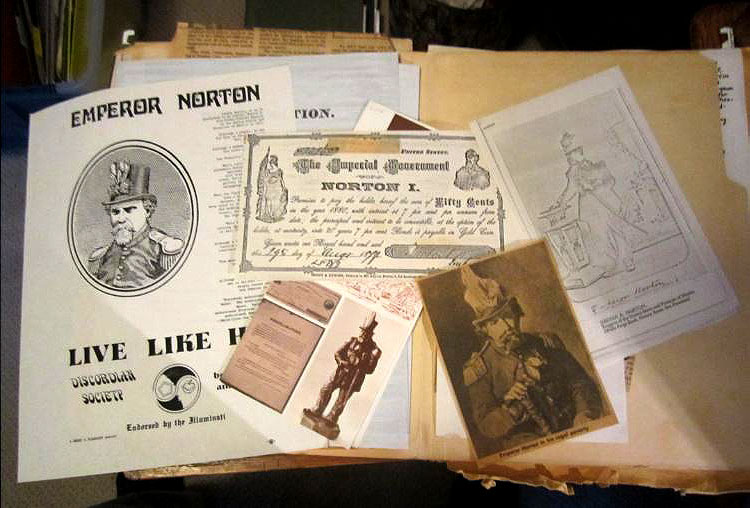
Courtesy of the Discordian Archives.
One of the Saints of Discordia (and saints do not have to be dead, agreed upon or even have a factual existence) is a historical figure by the name of Emperor Norton.
I set off on a mission to visit Norton’s grave, while I was in San Francisco. It turned out I wasn’t the only one who would do so with some frequency. After I walked all the way up, to the top of the steep hill of the graveyard, I gave up on finding Norton’s grave by myself and walked back down to the reception space to ask for help.
“I’m looking to visit a particular grave,” I said. “They’re a well known figure, known as Emperor Norton.”
The lady behind the desk knew immediately who I was after, and produced a photocopied map out from behind the desk.
“We get a lot of people coming to see the Emperor,” she said.
Emperor Norton was born in 1819 in England, but was taken very young to South Africa from where he emigrated to San Francisco in 1849. He made his money as a business person for sometime, until he lost his fortune in a bad investment in Peruvian rice. Norton claimed the supplier had misled him and appealed to the courts to help him out. While early rulings were in his favor, the Supreme Court of California ruled against him. He left San Francisco after this poor fortune, but returned again years later. When he did, he was to become a local legend.
On Norton’s return he no longer took the name of Joshua, and now claimed to be of royal lineage. In a conversation with his friend Nathan Peiser, he explained that he believed himself to be French royalty, sent to England as a child for his own safety, as indeed many children of French Royalty had done during the French revolution, as a response to the generally negative health implications of combining guillotines with angry mobs. Norton realized he had been given the Jewish name Joshua from his adoptive parents as a way to protect him from assassins.
Upon his return, he demanded the dissolution of the United States Government and declared himself Emperor of the United States of America, through the following notice, published by the San Francisco Bulletin in 1859;
At the peremptory request and desire of a large majority of the citizens of these United States, I, Joshua Norton, formerly of Algoa Bay, Cape of Good Hope, and now for the last 9 years and 10 months past of S. F., Cal., declare and proclaim myself Emperor of these U. S.; and in virtue of the authority thereby in me vested, do hereby order and direct the representatives of the different States of the Union to assemble in Musical Hall, of this city, on the 1st day of Feb. next, then and there to make such alterations in the existing laws of the Union as may ameliorate the evils under which the country is laboring, and thereby cause confidence to exist, both at home and abroad, in our stability and integrity.
—NORTON I, Emperor of the United States.
Norton, in many other cities, would have been a curiosity quickly forgotten, but San Francisco embraced him wholeheartedly. It had after all, become a tourist destination in recent history, and Norton had proved himself a character worth writing home about. Tourists were good for Norton personally, as well as San Francisco, providing a market for his Imperial Treasury Bond Certificates (to be repayed, apparently, at 7% interest in the year 1880).
As an additional title, for a little under a decade, Norton also took on the title of Protector of Mexico. He eventually gave up the title, stating “It is impossible to protect such an unsettled nation.”
While certainly destitute and possibly mentally ill, the city of San Francisco celebrated Norton so that he was never plunged too desperately into despair. While some tales of Norton seem suggest that his eccentricity allowed him to effectively live the regal life of an emperor, this seems to be quite the exaggeration. William Drury’s biography Norton I, Emperor of the United States seems to be the main source of most information available anywhere on Norton’s life, painting a somewhat less rosy picture of Norton’s economically challenged existence. However, some companies would set aside tables or seats for Norton’s use and deliver him meals in specially reserved plates and accept his self-issued currency, generally given out in 50 cent denominations.
Norton would be dressed in a blue uniform, with gold-plated epaulets provided by army officers and a beaver hat further decorated with a peacock feather and rosette. There are accounts that say he was known to inspect the condition of public property and the dress standards of police officers, to give philosophical expositions, to attend plays in seats reserved for him, and to eat for free in establishments that valued his presence for the publicity, sometimes with brass plaques under the entrance declaring “by Appointment to his Imperial Majesty, Emperor Norton I of the United States.”
The Encyclopedia of San Francisco suggests he spent 50 cents-a-night (not self-issued currency) for accommodation. He would walk to the Empire Hostel to read his paper, then spend the day on a park bench with friends including the Chinese man Ah How. Norton would decry the unequal treatment of the Chinese in San Francisco.
One story suggests that Norton once stood between a violent mob and Chinese workers during an anti-Chinese riot, protecting the Chinese workers by repeating the Lord’s Prayer until the rioters dispersed.
Norton was said to be good at chess and a great reader who spent much time in these activities at the libraries of various San Francisco clubs. He also used their stationary for the purpose of writing some of his proclamations. He attended church on Sundays, alternating the church he visited. On Saturdays, he attended a Jewish temple. Of this, Norton said, “I think it is my duty to encourage religion and morality by showing myself at church and to avoid jealousy I attend them all in turn.”
William Drury said of Norton, “He carried a dignified and regal air about him, but was seen as a kind, affable man, inclined to be jocular in conversation. He spoke rationally and intelligently about any subject, except about himself or his empire.”
It is suggested, by Samuel Dickinson in Tales of San Francisco, that Norton would be accompanied at plays by two other San Francisco celebrities, a pair of mongrel dogs named Bummer and Lazarus, who were by some accounts, pets of Norton. Stray dogs were, by law, destroyed, but these two had been adopted by the Board of Supervisors, as a reward for their duties in killing the rats that overran the city. Both dogs were well known in San Francisco, and SF resident Mark Twain provided a eulogy for Lazarus when he died. Twain also knew Norton, and based the character of “the King” who appeared in The Adventures of Huck Finn on him. Of Norton he said; “O dear, it was always a painful thing for me to see the Emperor begging, for although nobody else believed he was an emperor, he believed it.”
In 1867 Norton was arrested and placed in a mental institution, though outrage from the public ensured his release. He offered an Imperial Pardon to the policeman responsible, and thereafter was saluted by the police as he passed.
Norton was occasionally the victim of practical jokes in this mode. He was occasionally sent telegrams that alleged to be from other political figures of the time, or he would discover that some other bright spark had been issuing proclamations in his name. As far as can be known, he seems to have suffered these indignities with good grace, with the exception of a broken window in the case of a particularly insulting cartoon. Certain falsified telegrams, perhaps a prank on the emperor, were found amongst his possessions upon his death, along with very small amounts of money.
Norton died in 1880, succumbing to a sanguineous apoplexy. His funeral was large, by some accounts having 30,000 attendees. He was buried in a rosewood casket, provided by a business men’s association, the Pacific Club, at the Masonic Cemetery and at the expense of the city of San Francisco.
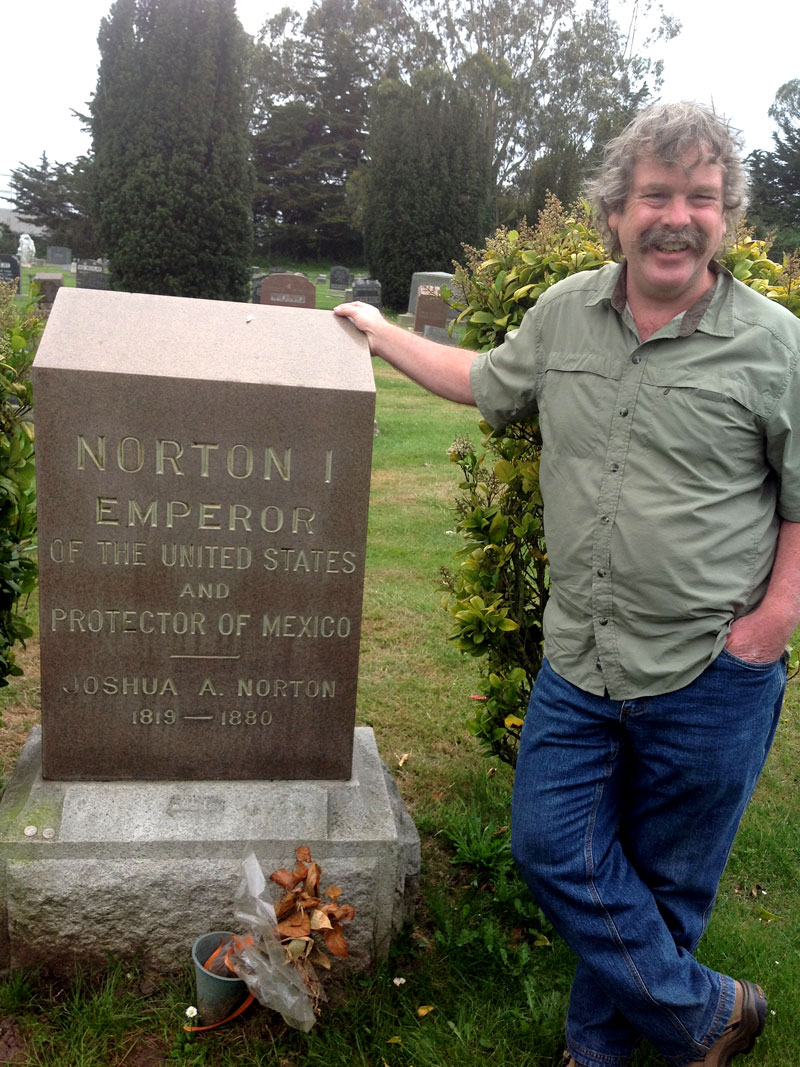
to Emperor Norton's gravesite.
Courtesy of the Discordian Archives.
I spent a little time at Norton’s grave site. In a funny way I felt thankful to him for his example, for the audacity of his madness, and the way in which he gave an example of creating a new reality through consensus, by inviting others to play along. I left some coins, as others had, at the base of his tombstone, and a Pope Card too.
The group E Clampus Vitus hold a party yearly at Norton’s grave. Other groups, such as one assembly of KallistiCon as mentioned in the Portland chapter, as well as individual Discordians, hold events or pilgrimages to Norton’s grave.
Norton’s laws and directives included the following;
1859: Congress is to be abolished.
1859: Gov. Wise of Virginia is dismissed from office, for the hanging of John Brown.
1860: Congress, having refused Norton’s imperial decree is to be forcefully disbanded by the United States Military.
1861: A new theater, Tucker’s Hall, opened with a performance of “Norton the First,” or “An Emperor for a Day.”
1862: The Roman Catholic and Protestant church need both publicly recognize Norton as Emperor.
1869: The Republican and Democratic parties of America are both abolished.
1869: Sacramento is required to clean its muddy streets and install gaslights.
1872: A $25 fine is issued to any person who refers to San Francisco as ‘Frisco.
1872: A suspension bridge is to be built between Oakland and San Francisco. (This one was eventually obeyed long after Norton’s death)
Norton influenced the works of writers such as Twain, Neil Gaiman and Robert Lewis Stevenson. He is also heavily represented in Discordianism.
Norton is listed in the Principia Discordia as an example of a second class saint—being Saints who, by their existence, are ineligible for higher levels of Sainthood, which are reserved for nonexistent saints.
Page 14 of the Principia is taken up entirely by an altered image of Norton’s money.
One manifestation of the Discordians Society in San Francisco was titled The Joshua Norton Cabal. Their slogan was: Everybody understands Mickey Mouse. Few understand Hermann Hesse. Only a handful understood Albert Einstein. And nobody understood Emperor Norton.
This cabal was fictionalized in Robert Anton Wilson and Robert Shae’s classic Discordian work Illuminatus! as a renegade gang poised to resist the Illuminati. Character Doc Iggy gives the following explanation of the cabal
Well, chew on this for a while, friend: there were two very sane and rational anarchists who lived about the same time as Emperor Norton across the country in Massachusetts: William Green and Lysander Spooner. They also realized the value of having competing currencies instead of one uniform State currency, and they tried logical arguments, empirical demonstrations and legal suits ‘to get this idea accepted’. They accomplished nothing. The government broke its own laws to find ways to suppress Green’s Mutual Bank and Spooner’s People’s Bank. That’s because they were obviously sane, and their currency did pose a real threat to the monopoly of the Illuminati. But Emperor Norton was so crazy that people humored him and his currency was allowed to circulate. Think about it.
In the introduction to the purple cover edition by IllumiNet Press of the Principia Discordia, Kerry Thornley has the following to say on Norton:
We asked Goddess if She, like God, had an Only Begotten Son. She assured us that She did and gave His name as Emperor Norton I—whom we assumed was probably some Byzantine ruler of Constantinople. Diligent research eventually turned up the historical Norton, as we call Him, in the holy city of San Francisco—where He walked His faithful dog along Market Street scarcely more than a century ago….
He ended by saying:
Perhaps occasionally the soul of Emperor Norton descends once more into the world to momentarily inhabit the body of an otherwise undistinguished infidel. One day I was sitting in a hamburger stand in rundown Midtown Atlanta. A burned-out speed freak at a nearby table looked at me with a pleasant smile and said, “I’m King of the Universe. I don’t know what I’m doing in a place like this.”
And perhaps that’s the big attraction of our faith. If you want, you can be King of the Universe. Jesse Sump is Ancient Abbreviated Calif. of California. I am Bull Goose of Limbo and President of the Fair-Play-for-Switzerland Committee. Camden Benares is Pretender to the Throne of Lesbos. Greg Hill is Polyfather of Virginity-in-Gold. Sabal Etonia is High Constable of Constantinople. You can declare yourself Archbishop of Abyssinia or Curator of the Moon—we don’t care, but your mailman will be impressed.
The final version of this article will appear in my forthcoming book Chasing Eris.
Greg Hill’s Note To Self
Apparently, Greg planned to ordain David Ossman of the Firesign Theatre at one point, although I don’t know if this Discordian ordination ever actually occurred, short of Greg sending Ossman a Pope Card, which probably did nothing more than mystify the poor fellow, wondering who the heck this Malaclypse character was.
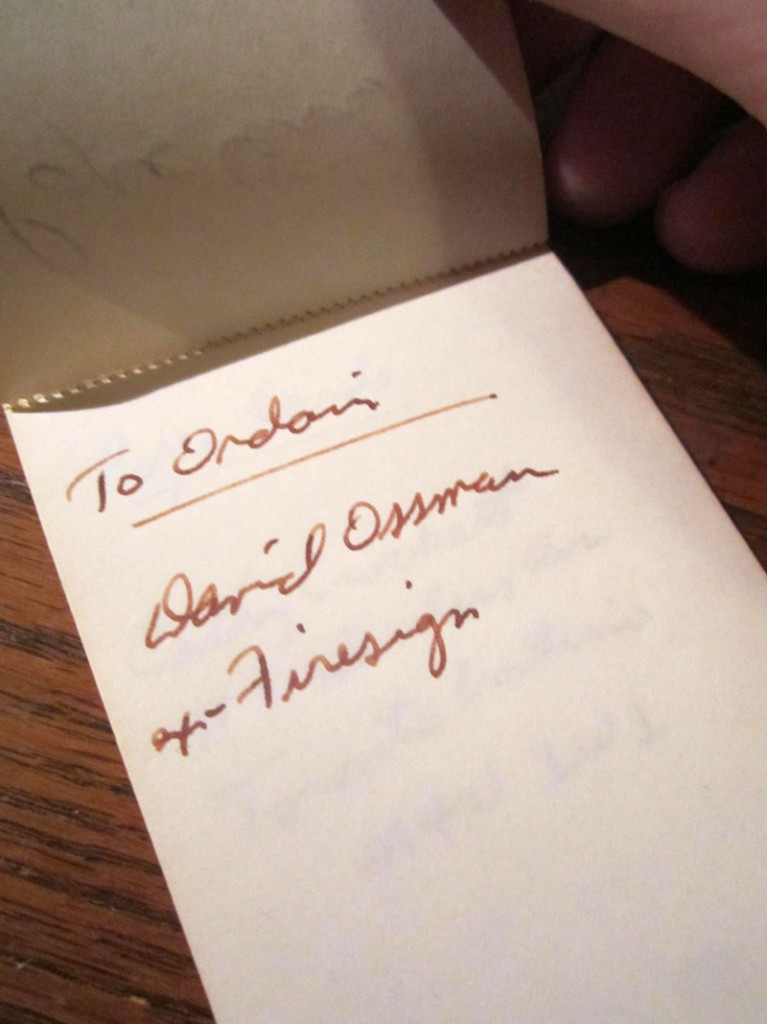
Courtesy of the Discordian Archives.

Several years after the release of The Prankster, your humble reporter stumbled upon a wealth of new information related to Kerry Thornley and the Jim Garrison case which, in turn, led to an ever-deeper examination of this seemingly never-ending rabbit hole that encompassed such a large and troubling part of Kerry Thornley’s life. (And mine, as well!)
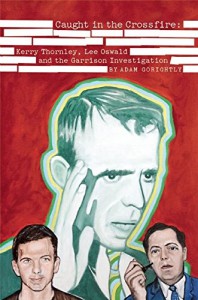
Amazon Today!
On a related note, I share with you now a Historia Discordia Exclusive snipped from Rev. Wyrdsli’s seminal 1992 video interview with Thornley at A Cappella Books, wherein Kerry discusses many of the strange and intimate details that will further emerge, and be expanded upon, in Caught In The Crossfire.

Brenton Clutterbuck
Here’s a hint of what went down in London.
—Brenton Clutterbuck
We’ve reached part two of the Chasing Eris adventure. I’ve taken my accommodation in Bristol, a city full of artistic energy, close to my intended interviewees. On one of my first days in the city, I jump on a train to London.
There are two great stories of Discordia waiting to be told here. One is of The KLF, the superstar band that took the world by storm, before quitting the music business and burning a million pounds of cash. The starting point of that first story grows out of the fertile, imaginative ground of our second story—the Illuminatus! Play of November 23, 1976.
Robert Anton Wilson first discovered Discordianism through his mail correspondence with Kerry Thornley in 1967. In a 1992 interview with Reverend Wyrdsli, Thornley discussed Wilson’s interest in Discordia:
He said, very early in our relationship that one of the things we needed were God models that were appropriate to anarchism. And he had written some stuff about Taoism and the spirit of the Valley Lady: the eternal female, and about Shang Dynasty matrism and so on and so forth. So I suggested to him Eris Discordia and told him about the Discordian Society, and he was just very enthused about it, plunged into it, got very active in it, and was responsible for a lot of our creeds and dogmas and so on and so forth.
Robert Anton Wilson would become involved in Operation Mindfuck that next year, participating in various Discordian shenanigans, including the development of a large mythos built-up around the Bavarian Illuminati. This mythos would appear to have gone on to influence the modern pop-cultural idea of the Illuminati, from books such as Umberto Eco’s conspiracy classic Foucault’s Pendulum (Amazon) to the pop-culture runaway successes of Dan Brown’s novels The Da Vinci Code (Amazon) and Angels and Demons (Amazon), and the film adaptation of Lara Croft: Tomb Raider (Amazon Instant Video), though Wilson’s influence is seldom credited.
Robert Shea, the editor of anarchist zine No Governor was Wilson’s partner in crime. The pair were working together editing the Playboy Forum letters section. A number of the letters they received were from paranoids (or most likely letters Shea & Wilson planted), alleging that they were the target of various conspiracies. Using the concept that perhaps every single one of the alleged conspiracies was true, they began work on the Illuminatus! Trilogy (Amazon).
One of the plot devices of Illuminatus! was that it featured a long-running feud between the Discordians and the Illuminati. This was a theme that had previously been carried through a number of Discordian writings in the zine scene, and was invoked in the Illuminatus! Trilogy at Shea’s suggestion.
The first volume of Illuminatus! was released in 1975, and did a great deal to popularize Discordianism. Readers mistakenly assumed the mysterious Principia Discordia mentioned in Illuminatus! was one of the many fabrications of Shea and Wilson, and were later often stunned to learn the Principia Discordia was, in fact, real.
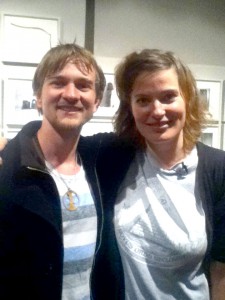
Ken Campbell's daughter,
Daisy Eris Campbell. Check out
her production of
RAW's Cosmic Trigger.
Courtesy of Brenton Cluttberuck.
As a result, Illuminatus! became the first project to be performed in Liverpool Theatre of Language, Music, Dream and Pun.
Anyone who has seen a copy of Illuminatus! has had the sheer size of the work impressed upon them. Completing it is no mean feat. Adapting it down to the size of a typical play would be an even more daunting feat. However Campbell took it a step further; instead of cutting out huge chunks of the text he kept the work at largely its original size, and developed eight-and-a-half hours of performance. In Liverpool he presented five plays over five nights, with the fifth being a presentation of all five; one after the other in a mammoth all day performance.
The creative team behind the play included Chris Langham—who helped produce the play alongside Campbell—as lead role George Dorn, Jim Broadbent in a number of minor roles including biological weapon designer Dr. Charles Moncenigo and the sadistic Sheriff Jim Cartwright, Bill Nighy as magazine editor Joe Malik, David Rappaport as Markoff Chainey, and the work of Bill Drummond, later of The KLF fame, as a set designer.
I walked up to the National Theatre. After the Liverpool shows the play moved on to performances in Amsterdam, before finally coming to London. I had come here just to stand in front of the theatre and do a small video talking about the play, but thought I’d try my luck wandering on in and asking at the theatre shop if they knew anything about the Trilogy. They referred me to the National Theatre Archive which, in my ignorance, I had not known about.
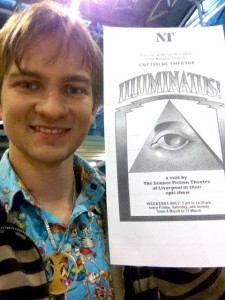
I pulled out several newspaper articles. Most were reviews, but a small number stood out in particular as bizarre oddities that contributed an additional layer of weirdness to the already larger than life Illuminatus! saga.
One article was titled “Horror Mission of an Actor Obsessed with the Occult” from the Daily Mail, dated September 7, 1982 about Illuminatus! cast member Chris Taynton whose roles included the pimp Carmel and Robert Putney Drake, the head of the American Crime Syndicate. The article told of how Taynton, believing he had been overcome by alien forces, attacked Adrena Smith, a 57-year-old lady, by stabbing her multiple times. He blinded her in one eye, and killed her pets, including cutting the ears off her dog. Taynton’s involvement in the Illuminatus! play was raised in court by his defense lawyer, Patricia May, specifically in regard to the play’s supernatural and occult themes.
“Having taken an extremely exciting part in a somewhat bizarre play he became more and more involved in the principles that were propounded in that play,” said May.
It seems a number of the cast went on to have troubled futures. David Rappaport, a dwarf actor, who also played a main role in Terry Gilliam’s movie Time Bandits (Amazon Instant Video), struggled with depression in his later life and ended up shooting himself fatally in the chest in 1990, in Laurel Canyon Park, California.
Chris Langham too was jailed for 10 months in 2007 for possessing Level Five child pornography, which he claimed was both part of researching a character and helping himself deal with his own abuse as an eight year old child.
Before we enter into The Curse of Tutankhamen territory, it’s worth noting not all actors in Illuminatus! had such tragic futures waiting for them. Jim Broadbent and Bill Nighy continue to enjoy prosperous acting careers, and Ken Campbell left a legacy of genius (as well as a record for longest play ever—not in fact for Illuminatus!—but for his 22-hour long The Warp). He was remembered by Liverpool Everyman Theatre and Playhouse Artistic Director Gemma Bodinetz as “The door through which many hundreds of kindred souls entered a madder, braver, brighter, funnier and more complex universe.”
Another, less ghoulish article I read was titled “Raising School Fees for Gorilla,” and was published in The Guardian on April 19, 1977.
In Illuminatus!, our intrepid heroes encounter a group of gorillas. Hagbard Celine, played by Neil Cunningham, has a conversation with them in Swahili (the gorillas all speak English, but are much more comfortable with Swahili). When Malik (Bill Nighy) asks if Celine taught the gorillas to speak, he responds that the gorillas have always been able to speak, but have largely kept their abilities secret:
“…the gorillas themselves are too shrewd to talk to anybody but another anarchist. They’re all anarchists themselves, you know, and they have a very healthy wariness about people in general and government people in particular. As one of them told me once, ‘If it got out that we can talk, the conservatives would exterminate most of us and make the rest pay rent to live on our own land; and the liberals would try to train us to be engine-lathe operators. Who the fuck wants to operate an engine lathe?’ They prefer their own pastoral and Eristic ways, and I, for one, would never interfere with them.”
Meanwhile in the “real” world at Stanford University, apparently unaware of the gorillas’ long term bluff, Miss Penny Patterson was busy trying to teach English to Koko the Gorilla.
Koko, according to the book Drawing the Line: Science and the Case for Animal Rights (Amazon), knew 2000 spoken English words and 1000 words in American Sign Language as of 2003. However, in 1977, the project was in very real danger of running out of money, the result to be that Koko would find herself returned to the San Francisco Zoo.
Perhaps because of the plot connection, or perhaps for other more incomprehensible and possibly synchronistic reasons, the Science Fiction Theatre of Liverpool (the organization run by Campbell and Langham specifically to produce the play) decided to support the project, even going as far as to consider adding an optional 50p levy to the audience in addition to setting up a stall to raise money.
“It was exactly the sort of research we think should be continued,” said Nighy.
“You never know what might be found out,” Campbell was quoted as saying.
The complete version of this article will appear in my forthcoming book Chasing Eris.
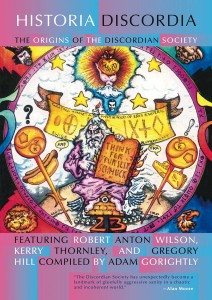
The Origins of the
Discordian Society.
Get Your Copy Now!
with Adam Gorightly:
Anarchism, synchronicity, and the joke religion spawned by the vision of a Goddess in a bowling alley: a talk with “crackpot historian” Adam Gorightly about his new book Historia Discordia: The Origins of the Discordian Society.
Hail Eris!
The above interview of RAW on Aleister Crowley was a real eye opener for me when I initially heard it back in the 90s, as RAW was the first observer (that I recall) who drew a comparison between Crowley’s portrait of Lam and the alien gray illustration on the cover of Whitley Strieber’s Communion (Amazon), which of course suggested that maybe dear old Uncle Al had once upon a time summoned certain entities (of the gray skin Zeta Reticuli variety) onto the earth plane that over the last few decades have been abducting and probing and doing such things that alien grays are wont to do.
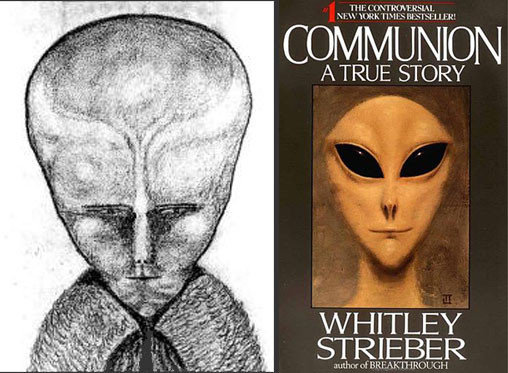
The obvious difference between Lam, and Strieber’s alien gray, is the eyes. However, Fortean researcher Regan Lee made a keen observation recently pointing out that if you look above Lam’s eyes you will see alien gray eyes on his forehead, and that once you notice this, it’s impossible NOT to see them.
Lam—as the story goes—was the apparent product of a magick ritual called the Amalantrah Working that Crowley performed way back in 1917. There are even those who suspect that Crowley intentionally opened a Stargate by the practice of such ritual workings which allowed the likes of Lam and other otherworldly entities a passageway onto the earth-plane. It was through a similar Crowleyean ritual that RAW made contact with what he perceived as entities from the star system Sirius—but that’s a rabbit hole we won’t go any further with at the moment.
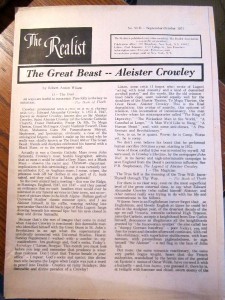
A noted protégé of Crowley’s was Jack Parsons, a renowned rocket scientist and co-founder of Jet Propulsions Laboratory. In 1946—with the aid of the future founder of Scientology, L. Ron Hubbard—the two men contacted beings not unlike Crowley’s Lam while performing a series of rituals called the Babalon Working in California’s Mojave Desert, a hotbed of UFO activity throughout the early days of UFO sightings.
Around the time that Hubbard and Parsons began the Babalon Working, a lady named Marjorie Cameron showed up at Parsons’ house (also known as The Parsonage), which served as the OTO Agape Lodge headquarters for Southern California, as well as a notorious bohemian hangout and purported drug den. A couple weeks after arriving at The Parsonage, Cameron claimed that she witnessed a silver cigar shaped UFO. To Parsons this incident was a sign that Cameron was the chosen one with whom to conduct the Babalon Working, the intent of which was to create a “child” in the spiritual realms who would be “called down” and directed it into the womb of a female volunteer. When born, this child would incarnate the forces of Babalon and become the Scarlet Woman of Revelations, symbolizing the dawning of the Age of Horus, the coming new age.
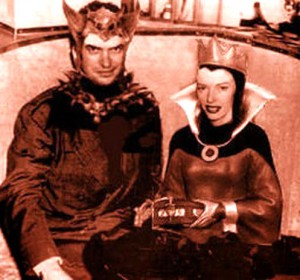
As with Crowley, RAW was also an admirer of Jack Parsons, as can be seen in the following Youtube interview, which is broken up into four parts.
More on Parsons here.
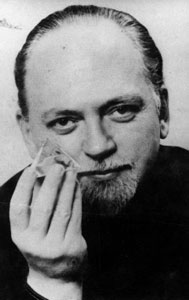
I have now encountered the “real” Head of the “real” Illuminati several times…. The first real Head I met was Rev. Thomas Patrick McNamara of San Francisco. He is a charming and witty person. The second real Head is Robert Shell from Roanoke, Virginia. I haven’t met him in person yet, but we’ve corresponded quite a bit, and he seems charming and witty also. The third real Head is an individual in southern California who shall be nameless and who is neither charming or witty. He threatened to sue me for a put-on letter I had written to an occult journal, Green Egg, in which I had jokingly pretended I was the real Head of the Illuminati. I sent him back a form saying his letter would not program into my computer and would he please resubmit it in Fortran; I haven’t heard back from him since. Another real Head of the Illuminati is a chap called Frater Paragranis, in Switzerland, who registered his to that title in Francis King’s book, Sexuality, Magick and Perversion.
I have also been corresponding for a year now with a 33º freemason in Texas. Part of the time I think he’s the real Real Head of the Illuminati. Part of the time I think that he thinks I’m the Real Head. And part of the time I think he just likes to correspond with professional writers about occult subjects…
Over the years (as RAW notes in Cosmic Trigger) some suggested that he was the Real Head of the Illuminati, which of course RAW would never actually confirm or deny—not because it was either true or false—but because it was more amusing to let people believe whatever they wanted to believe… and it probably didn’t hurt book sales of Illuminatus! either. Whatever the case, around 2003 I posed to RAW this very same question, inquiring if he was indeed the one and only Head of the Illuminati, and his answer, in typical satiric fashion, was “No, I’m the toe.” This wasn’t exactly the response I was looking for, but just the same I asked if he’d appoint me an Illuminati High Priest, to which he didn’t hesitate one second: “You are hereby appointed.” And although this lofty position hasn’t improved my sex life or finances to any measurable degree, you must admit it’s one hell of an honor belonging to a secret order associated with Robert Anton Wilson.
However—due to information shared with me by J Fox Sircy—there is evidence to suggest that RAW (in the previous passage from Cosmic Trigger) may have identified the Head of the Illuminati and the Head of the Ordo Templi Orientis (OTO) as one and the same person—which hopefully will become more clear to you, dear readers, as you continue on through this post. To this end, certain conspiracy theorists have suggested that OTO grand poobah Aleister Crowley was also a high level Illuminati Master, whatever that actually entails.
As history instructs, a freemason-enthusiast named Theodor Reuss founded the OTO in Germany in 1906, which at its outset was a seemingly mundane mystical order that Crowley later joined in 1912. In short order, Uncle Al finagled his way to the position of Head of the British OTO branch, introducing many new rituals into their ceremonies, including some with a decidedly sexual spin, ooh la la.
Crowley—as he was wont to do—eventually burned his bridges with OTO leadership, who in short order kissed his ass goodbye, in the process stripping Uncle Al of all his illustrious OTO titles, which probably didn’t mean all that much to Crowley anyway. Just to spite his former OTO brethren and sistern, Crowley proclaimed himself the Outer Head of the OTO (OHO), a sort of outcast leader in exile who, in the years to come, would serve as spiritual father to upstart OTO chapters in the US, such as Jack Parsons’ Agape Lodge, active in Los Angeles during the 1940s and early-50s.
Prior his death in 1947, Crowley appointed as his successor (otherwise known in OTO-speak as ‘Caliph’) a fellow named Grady McMurty, a former member of Parson’s Agape Lodge, who would later become good friends with RAW during the period both lived in Berkeley in the early-70s. However, some disputed McMurty’s appointment to Caliph-hood, claiming that they (the people disputing McMurty) were the true Caliph(s), among them British occultist Kenneth Grant, Hermann Metzger (who I suspect was RAW’s correspondent in Switzerland, Frater Paragranis, mentioned in Cosmic Trigger) and Brazilian Marcelo Motta.
Such disputes as these led to seemingly endless internal OTO squabbles throughout the years, as documented in the following editorial by Marcelo Motta from the 1981 edition of The Equinox (Vol. 5, No. 4), in which Motta lists a countercultural rogue’s gallery engaged in unsanctioned OTO pursuits that included such notables as experimental film director Kenneth Anger, Grand Caliph Grady McMurty and, most notably, RAW.
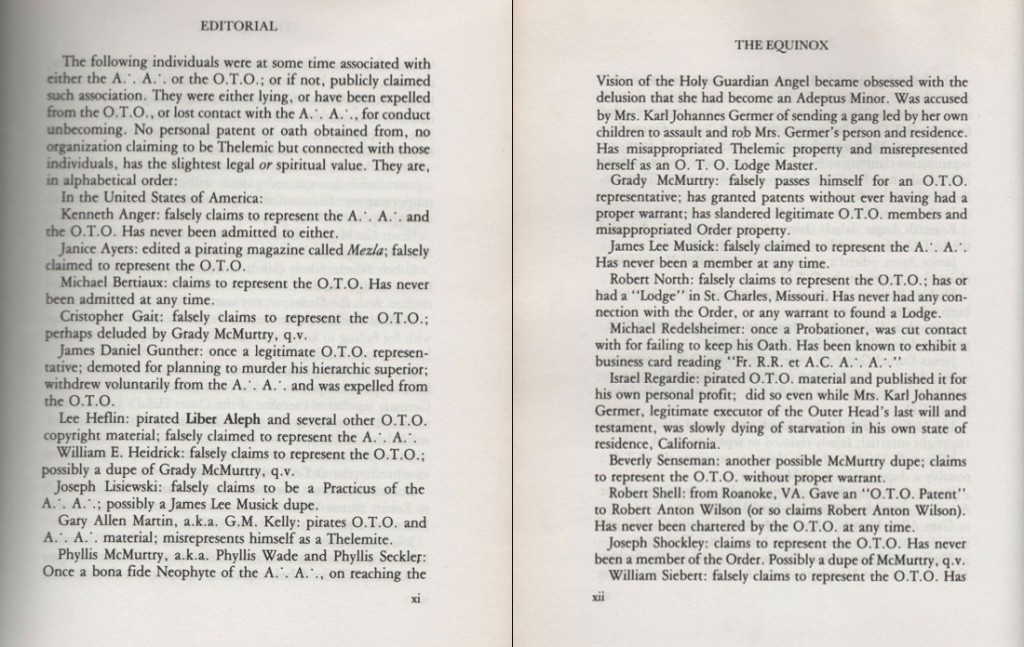
Motta’s main bone of contention in regards to RAW related to the above quoted Cosmic Trigger passage about the charming and witty Robert Shell of Roanoke, Virginia, who—according to Motta—granted RAW an “OTO Patent” which allowed RAW to proclaim himself an OHO and, in turn, print his own OHO cards (authorized by Baphomet, no less!) thereby allowing each recipient thereof to likewise proclaim themselves an OHO (in the OTO!) much in the same manner that anyone anywhere anytime could proclaim themselves a Discordian Pope.
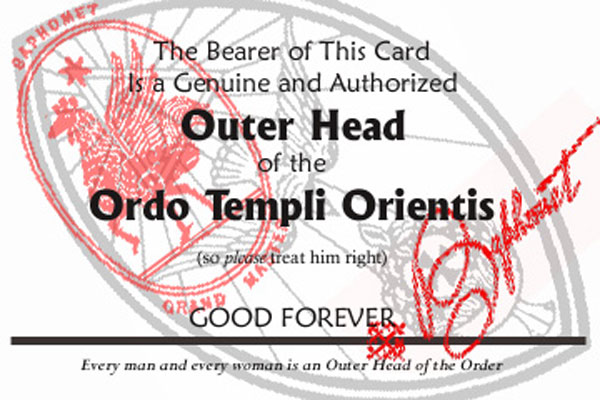
In fact, these OHO cards greatly resemble the famous Discordian Pope cards we’ve all grown to know and love. And, of course, OTO leadership (or those who claimed to be the true OTO leadership) didn’t dig this one little bit as it allowed the uninitiated (read: the profane!) OHO status while not having jumped through all the required and authorized OTO hoops that are supposed to be passed through to attain such lofty status. (I’m sure RAW was laughing his ass off about all this.) To confuse things even more, RAW (in Cosmic Trigger) seems to have intentionally misidentified the Head of the OHO as the Head of the Illuminati—unless he was privy to certain secret society secrets which confirmed that the Illuminati were, in fact, OTO adepts!
Although unsubstantiated at this point, our crack research staff here at Historia Discordia have heard rumor that—during the period RAW was passing out these OHO cards in the 1970s—the official OTO “patent” had lapsed and, in the interim, he had achieved a high enough OTO rank to make his OHO cards “official.” So, in effect, RAW owned a “patent” that legally permitted him to distribute these cards. It can be further conjectured that the aforementioned Robert Shell of Roanoke, Virginia was the OTO Adept who—through written correspondence—awarded RAW his highest OTO level thus authorizing his “patent,” an offense that purported Caliph Marcelo Motta considered so egregious that he publicly denounced RAW.
And this pleased the Goddess.
UPDATE: While we strive for least 23% accuracy with at least 5% of our posts, I’ve just been informed that the OHO Card discussed above was actually created in the mid 90s by a fellow named David Schlesinger (aka Stone Mirror, the Great and Terrible!) who then shared it with RAW. For further clarification you’ll have to consult your pineal gland.
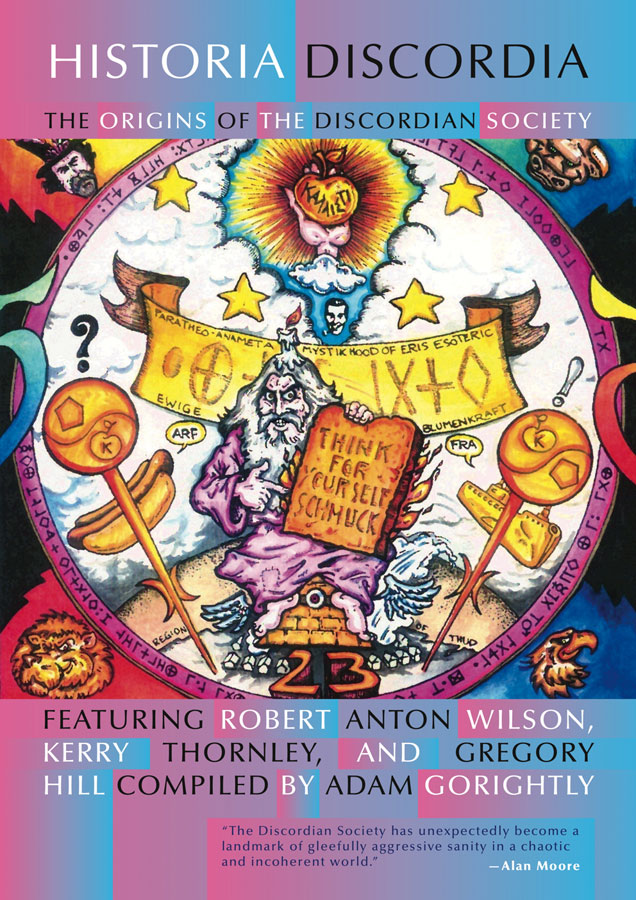
Historia Discordia: The Origins of the Discordian Society
Get Yer Copy Now!